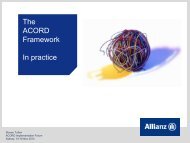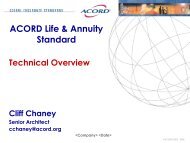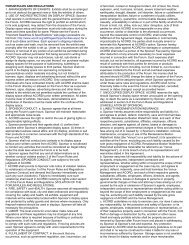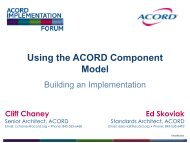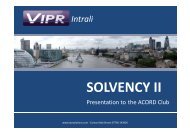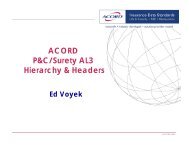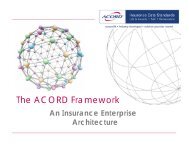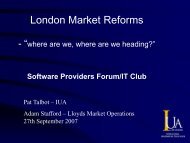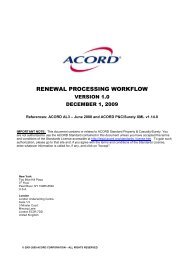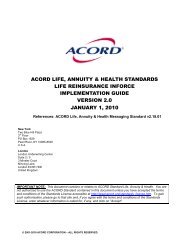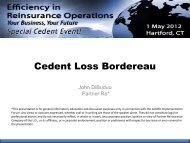Information Model - Acord
Information Model - Acord
Information Model - Acord
- No tags were found...
You also want an ePaper? Increase the reach of your titles
YUMPU automatically turns print PDFs into web optimized ePapers that Google loves.
The ACORD FrameworkAn InsuranceEnterpriseArchitecture© ACORD 2013
Framework Overview: Agenda• History / Origins / Business Need• The Five Facets• Relationship with ACORD Standards• Status• Getting Involved / Participation© ACORD 2013
ACORD is building the Frameworkfor the future of the industry• More diversemembership• Global membership• Cross-Domainmembership• Geographicaldifferences• More than anexchange format© ACORD 2013
ACORD is building the Frameworkfor greater efficiency• Need for an Enterprise Architecture• Framework streamlines standardscreation and development• Framework provides a base formodel driven development andmaintenance of standards• Framework better servesACORD members andthe entire insurance industry© ACORD 2013
The Framework will save yourorganization time and resources• ACORD Frameworkprovides the foundation forEnterprise Architectures• Diverse membershipcontribution• Members can choose partsthat are best suited© ACORD 2013
© ACORD 2013The Framework has 5 facets
UML(ish) View of Framework Facets© ACORD 2013
© ACORD 2013Questions?
The ACORD FrameworkBusinessGlossaryThe Business Glossary© ACORD 2013
The Business Glossary containscommon insurance definitions• Non-technical definitions• Single business glossary tobridge communication gaps• Provides context across allprograms© ACORD 2013
BusinessGlossaryThe Glossary relates tothe other four facets• Glossary terms found in allfacets• Changes made in unison© ACORD 2013
The Business Glossary© ACORD 2013
BusinessGlossaryThe Business Glossarystatus and delivery• Originally published in 2008• v2.3 published (September 2012)• Includes content aligned with:• v2.3 <strong>Information</strong> <strong>Model</strong>• HTML format• Future - will include Capability <strong>Model</strong> content© ACORD 2013
© ACORD 2013Questions?
The ACORD FrameworkProcessMapsThe Capability <strong>Model</strong>Capability<strong>Model</strong>© ACORD 2013
ProcessMapsCapability<strong>Model</strong>The Capability <strong>Model</strong>defines what theinsurance industry does• Scope begins with insurancecompanies, but is not limited toinsurers• Baseline of a company’scapabilities© ACORD 2013• Individual companies vary, butall capabilities exist in theindustry
ProcessMapsCapability<strong>Model</strong>The Capability <strong>Model</strong>presents astandard perspective• Does not define an ordered workflow, just reflectsthe industry’s capabilities and un-sequencedprocesses performed by them• The <strong>Model</strong> offers an organizational baseline, apreferred approach© ACORD 2013
ProcessMapsCapability<strong>Model</strong>The Capability <strong>Model</strong>helps facilitatebusiness innovation• Capability <strong>Model</strong> gives insight to areas ofsimilarity and shows differences from othercompanies• Companies can find innovative ways to exploitthose differences© ACORD 2013
ClaimsCapability <strong>Model</strong> includesProcess Maps• CapabilityClaims LifecycleManagement• Claims• Sub Capability:• Claims Lifecycle ManagementClaimsHandlingInvestigateClaim• Sub-sub Capability• Claims Handling• Activity / Process:• Investigate Claim© ACORD 2013
ProcessMapsCapability<strong>Model</strong>The Capability <strong>Model</strong>Top Level Capabilities• Business Management• Channel Management• Contract Administration• Customer Service• Enterprise Services• Claims• Finance• Marketing• Product• Sales© ACORD 2013
Common Capability <strong>Model</strong> Uses Business Process <strong>Model</strong>ing Capabilities and business activities provide thebuilding blocks for business process automation Delivered in UML for ease of porting into BPM tooling Business Activity Reference <strong>Model</strong> A common model set of definitions that can beagreed upon across the industry Celent used the Capability <strong>Model</strong> as the base for theBPO questionnaire and report for 2011© ACORD 2013
ProcessMapsCapability<strong>Model</strong>The Capability <strong>Model</strong>status and deliveryoptions• Version 2.1 – released May, 2011• No major revisions expected• Formats: Spreadsheet and UMLUML SampleSpreadsheet Sample© ACORD 2013
v2.1 Release – What’s New?• tele-underwriting• help desk service• document imaging• predictive modeling• several claims items• UML updates to align with SpreadsheetProcessMapsCapability<strong>Model</strong>© ACORD 2013
The Book…• Available Now– URL belowhttp://www.acord.org/Knowledge/Resources/Library/Documents/ACORDCapability<strong>Model</strong>Book_2010.pdf© ACORD 2013
ProcessMapsCapability<strong>Model</strong>The Capability <strong>Model</strong>History & Future© ACORD 2013Year Activity / Donation ACORD Publication2006 IBM (IAA process definitions)2007 ACORD v1.0 Draft2008 Deloitte, LLC (enterprisesupport)ACORD Working Group(harmonization)2009 ACORD v2.02010 ACORD Capability <strong>Model</strong> Book2011 New Content / Donations v2.12013 Re-start Working Group(alignment to Capability andComponent <strong>Model</strong>s)
© ACORD 2013Questions?
The ACORD FrameworkThe <strong>Information</strong> <strong>Model</strong>© ACORD 2013
The <strong>Information</strong> <strong>Model</strong> organizes andrelates insurance concepts© ACORD 2013
The <strong>Information</strong> <strong>Model</strong> is the basisfor <strong>Model</strong>-Driven development ofstandards• Single business model• Consistency across allstandards development• Provides a big picture viewof the insurance industry<strong>Information</strong><strong>Model</strong>© ACORD 2013
The <strong>Information</strong> <strong>Model</strong> helpsorganize and explain insuranceconcepts• Linked to all the ACORD Standards• Other facets used to ensure consistency• Provides the mechanism for mapping all standardsto each other• <strong>Model</strong> currently contains:– More than 800 classes– More than 2300 attributes– More than 400 associations<strong>Information</strong><strong>Model</strong>© ACORD 2013
The <strong>Information</strong> <strong>Model</strong> is aboutconcepts, not literal implementations• Can express ideas independentlyof how they are used• Not intended to describe how touse the concepts• Designed for extensibility toaccommodate future standardsand industry requirements• View is context-neutral or context-agnostic(e.g. “data at rest“)<strong>Information</strong><strong>Model</strong>© ACORD 2013
Common <strong>Information</strong> <strong>Model</strong> Uses Enterprise Reference <strong>Model</strong> Logical organization of like concepts Standard baseline for how concepts inter-relate Business focused Bridge between business and technical Canonical <strong>Model</strong>© ACORD 2013 A common model for data interoperability, twosystems that refer to the concept of an Agreement butname them differently (Contract versus Policy) Single source of data organization Needed for semantic integration
<strong>Information</strong> <strong>Model</strong> is the centralfacet for mapping which facilitatesease of implementation• ACORD will map the <strong>Information</strong> <strong>Model</strong> to:– XML standards (all versions)– Forms (eLabels)– EDI / AL3– Other standards and models• Members who map internal models to the<strong>Information</strong> <strong>Model</strong> then have a semanticlink to all standards<strong>Information</strong><strong>Model</strong>© ACORD 2013
Mapping creates linksfor ease of implementation• ACORD mapping will link:• Domains• Geographies• Facets• Standards• ACORD mappings savetime for you<strong>Information</strong><strong>Model</strong>© ACORD 2013
The Semantic Hub ConnectsMessages and Technology• <strong>Information</strong> <strong>Model</strong> isthe common bridge• Enables any-to-anyintegrationACORDLife, Annuity &Health StandardsACORDP&C/SuretyStandardsACORDReinsurance &Large CommercialStandards• Single source ofmeaning –<strong>Information</strong> <strong>Model</strong>OperationalData Store<strong>Information</strong><strong>Model</strong>ClaimsSystemDataWarehouseData <strong>Model</strong>PolicyAdmin.System© ACORD 2013
ESB View – Semantic Integration• Mapping each side tothe <strong>Information</strong> <strong>Model</strong>• Enterprise Service Bus(ESB) transformsprotocols, messages• Use the <strong>Information</strong><strong>Model</strong> as the centralsource<strong>Information</strong><strong>Model</strong>© ACORD 2013
MDMI View – Semantic IntegrationVocabulary• Expressing mappings betweendata interfaces in an industrystandard format – MDMIDataInterfaceA<strong>Information</strong> <strong>Model</strong>VocabularyDataInterfaceBMDMIDesignerImportant characteristics:• Ease-of-use – map datainterfaces to a flatvocabulary• Portability – use any <strong>Model</strong>Driven MessageInteroperability (MDMI)run-timeMDMIRun-timeDataAOMG MDMI Standard FormatMDMI EngineDataB
With the <strong>Information</strong> <strong>Model</strong>, allstandards can be traceable back tothe models used to create them• Consistent process for standards generation andmaintenance regardless of:– Type of standard (XML, eForm, etc)– Domain (P&C/Surety, LAH, RLC)– Line of business (Commercial, Personal, Life)• Changes will be made to the model first, thenpropagate out to the appropriate standards<strong>Information</strong><strong>Model</strong>© ACORD 2013
<strong>Information</strong><strong>Model</strong>The <strong>Information</strong> <strong>Model</strong>History & FutureYear Activity / Donation ACORD Publication2008 Prima Solutions (ICBS model)ACORD Working GroupACORDv1.0, v1.x2009 ACORD <strong>Information</strong> <strong>Model</strong> BookIBM (IAA – BOM)2010 ACORD (harmonization) v2.0 Beta (1-4)2011 ACORD v2.0 & v2.12012 ACORD v2.2 & v2.32013 Working Group Review V2.4 (Draft)© ACORD 2013
The <strong>Information</strong> <strong>Model</strong> top levelconcepts version 1.0<strong>Information</strong><strong>Model</strong>© ACORD 2013
Changes made to v1.x releases• PRS (Party Relationships) domain renamed to RRS (Roleand Relationships)• Documentation cleanup• The Role concept extended toinclude Physical Objects asRole players (Accident Vehicleon an Claim)• Relationship concept extended to include relationshipsbetween any roles, not just parties• Attribute, multiplicity and directed associationsmodified where needed (limited)<strong>Information</strong><strong>Model</strong>© ACORD 2013
Compare: Contract v1.xClaimContractFollowUpProposalAgreementContractContractHeaderPremiumIndividualContractGroupContractContractElementContractCoverageContractInvestmentVehicleInsuredSubjectProfileContractClauseCoverage SubjectMatter InvestmentVehicle© ACORD 2013
Contrast: Agreement v2.xGreen = New ContentPartyRoleInAgreementBusinessRelationshipSupervisionAgreementRegistrationAgreementDocumentAgreementRequestAgreementFinancialServicesAgreementProducerAgreementProviderAgreementEmploymentAgreementRiskAgreementAgreementComponentCoverageComponentRoleComponentAgreementClauseComponentAgreementFeatureComponentInsuranceAgreementAccountAgreementCommutationAgreementFrontingAgreementIndividualAgreementGroupAgreementDerivativeAgreement© ACORD 2013
<strong>Information</strong> <strong>Model</strong> v2.x: ScopeDelivered in: HTML, XMI, andMagicDraw native formats<strong>Information</strong><strong>Model</strong>© ACORD 2013
The <strong>Information</strong> <strong>Model</strong> v1.x and IBMBOM Harmonization• Both models provide significantcontent• Neither model is the “base” for theAIM 2.0• Concepts, patterns, designs andoverall organization strategies aretaken from both models• In some cases, neither model isused and newly formed patterns,designs, concepts andorganization strategies are created© ACORD 2013
The <strong>Information</strong> <strong>Model</strong> v1.x and IBMBOM Harmonization (cont’d)• Simple methodology created andapplied• Criteria setup and applied todesign decisions made• Regular review sessions conductedwith both Prima Solutions and IBM• Detailed logs created to tracedecision points and impact analysison both original models© ACORD 2013
Major design changes: v1.x and v2.x• Terminology changes:• “Domain” replaced by “Package”• “Sub-domain” replaced by “Subpackage”• Management domains removed• Management concepts combined intoappropriate subject areas• Packages added:• Activity, Assessment, Event, Registration<strong>Information</strong><strong>Model</strong>© ACORD 2013
Major design changes: v1.x and v2.x(cont’d)• Top level classes added• <strong>Information</strong><strong>Model</strong>Object• Category• Primitive data types are containedwithin the project instead of importingUML profiles to facilitate ease of XMIexport• Naming & Design Rules (NDR)• NDR created per XML NDR andcontent revised for conformance<strong>Information</strong><strong>Model</strong>© ACORD 2013
Some alignment pointsAIM v1.x IBM BOM AIM v2.xBusiness ActivityManagementContractContract ManagementClaimClaim ManagementClaimClaim ManagementActivityLegal ActionSpecification – Product andAgreementAssessment and ConditionClaimActivityAgreementAssessmentClaimN/A Category CategoryReferenceCommonBusiness <strong>Model</strong> ObjectActuarial Statistics and IndexCommon Elements© ACORD 2013
Some alignment points (cont’d)AIM v1.x IBM BOM AIM v2.xContactDocumentManagementBusiness ActivityManagementFinanceFinancial ManagementInvestmentInvestmentManagementMarketingContact Point and PreferencesPlaceStandard Text andCommunicationEventAccount and FundFinancial TransactionsMoney ProvisionGoal and NeedActivityGoal and NeedContact and PlaceDocument andCommunicationEventFinanceInvestmentMarketing© ACORD 2013
Some alignment points (cont’d)AIM v1.x IBM BOM AIM v2.xPartyParty ManagementOrganizationManagementPartyPartyObject Management Physical Object Physical ObjectProductSpecification – Product andAgreementProductSpecificationN/A Registration RegistrationRole and Relationship N/A Role andRelationship© ACORD 2013
Party© ACORD 2013
UseCases© ACORD 2013
<strong>Information</strong><strong>Model</strong>The <strong>Information</strong> <strong>Model</strong>History & FutureYear Activity / Donation ACORD Publication2008 Prima Solutions (ICBS model)ACORD Working GroupACORDv1.0, v1.x2009 ACORD <strong>Information</strong> <strong>Model</strong> BookIBM (IAA – BOM)2010 ACORD (harmonization) v2.0 Beta (1-4)2011 ACORD v2.0 & v2.12012 ACORD v2.2 & v2.32013 Working Group Review V2.4 (Draft)© ACORD 2013
© ACORD 2013Questions?
The ACORD FrameworkData<strong>Model</strong>The Data <strong>Model</strong>© ACORD 2013
The Data <strong>Model</strong> makesthe abstract more tangible• Turns concepts from <strong>Information</strong> <strong>Model</strong> intoformat that can be used for persistencedesign• Logical level persistence model• Can be used in anydatabase implementationData<strong>Model</strong>• Doesn’t consider data optimizationtechniques• Persistence = Storage© ACORD 2013
The Data <strong>Model</strong> has many uses• Help create a physical datamodel for databases• Provide a baseline for datawarehouses• Validate your data modelData<strong>Model</strong>© ACORD 2013
Guiding Principles• Use <strong>Information</strong> <strong>Model</strong> as source for Data <strong>Model</strong>– Provides content alignment and traceability– <strong>Information</strong> and Data <strong>Model</strong>s are always synchronized• No design or optimization decisions on behalf ofusers• Use a data modeling tool instead of just UML• Not designed for specific relational databasesoftware applicationsData<strong>Model</strong>© ACORD 2013
Data and <strong>Information</strong> <strong>Model</strong>Differences• Same content, different formats:– <strong>Information</strong> <strong>Model</strong> – Unified <strong>Model</strong>ing Language(UML)– Data <strong>Model</strong> – IBM InfoSphere Data Architect,Computer Associates ERwin• Different naming conventionsData<strong>Model</strong>• Added keys (big) to Data <strong>Model</strong>• Discriminators added to resolve inheritancestructures• Associative classes added to resolve M:Mrelationships© ACORD 2013
Same Content, Different FormatData<strong>Model</strong>© ACORD 2013
Same Content, Different FormatData<strong>Model</strong>© ACORD 2013
Same Content, Different FormatPrimary KeyNamingConventionsForeign KeyDiscriminatorData<strong>Model</strong>© ACORD 2013
A “Key” Issue…• UML is more free form than a data model• Keys are a big reason why• The model had several “key collisions” betweeninherited primary keys and related foreign keys withthe same name• We needed a way to handle thisData<strong>Model</strong>© ACORD 2013
An ExampleChildrenForeignKeysInheritedPrimaryKeyData<strong>Model</strong>InheritedPrimaryKey© ACORD 2013
The Data <strong>Model</strong> - StatusYear Activity ACORD Publication2009 Publication v1.0 (Nov.)2010 Publication v1.2 (April)2010 Publication v1.3 (July)2010 Begin construction v2.0 based on v2.0 (July)v2.0 of <strong>Information</strong> <strong>Model</strong>2011-2012Continue construction v2.x basedon v2.x of <strong>Information</strong> <strong>Model</strong>2012 Publication including ERwin andMagicDraw supportV2.3 Draft (Dec)Data<strong>Model</strong>2013 Add support for IBM InfoSphereData ArchitectV2.3 Beta 1 (Jan)HTML and Erwin formats available© ACORD 2013
© ACORD 2013Questions?
The ACORD FrameworkServiceMapsComponent<strong>Model</strong>The Component<strong>Model</strong>© ACORD 2013
The Component <strong>Model</strong>provides the buildingblocks for your solutionsComponent<strong>Model</strong>ServiceMaps• Components• Service Maps• Reusable for variousinsurance datatransactions© ACORD 2013
Component <strong>Model</strong> Vision• Design Framework• Technology Neutral• Independent• Interoperable• Reusable• InterchangeableComponent<strong>Model</strong>© ACORD 2013ServiceMapsThe Component <strong>Model</strong> defines a DESIGN FRAMEWORKthat allows for the INDEPENDENT development ofcomponents that INTEROPERATE to formapplications. It uses TECHNOLOGY NEUTRAL interfacesallowing for implementation across development platforms.With this design a single component is REUSABLE across multipleapplications and INTERCHANGEABLE with other components.
Components in the <strong>Model</strong>are formally definedComponent<strong>Model</strong>ServiceMaps• Provide a set ofrelated services• Can stand aloneor be mixedand matched© ACORD 2013
Components in the<strong>Model</strong> have welldefinedinterfacesComponent<strong>Model</strong>ServiceMaps• Data is controlled bythe component, not theapplications that use it• Interface is separate fromimplementation logic© ACORD 2013
Examples of componentsand their services via SOAComponent<strong>Model</strong>ServiceMapsComponentPartyContactProduct/AgreementPhysical ObjectClaimUnderwritingServiceManages persons, organizations, and the roles they playManages contact points: addresses, telephone, etc.Manages policy and coverage options and the policieswhich we writeManages information about things: vehicles, houses, etc.Manages the claim process and its applicable dataManages the underwriting process and its applicable data© ACORD 2013
Component <strong>Model</strong> : Create systemsusing different componentcombinations implementing commoninterfaces and service definitions=Claim System(Built or Bought)© ACORD 2013
A standardized Component <strong>Model</strong>creates a true plug and play environmentCustomer PortalClaimsAgency SystemPolicyAdministrationBillingInternal System© ACORD 2013CRM
Facets of theACORD FrameworkGlossary of terms usedby all other facets of theFrameworkThe relationshipsamong insuranceconceptsWhat insurancecompanies doLogical persistencemodel based on the<strong>Information</strong> <strong>Model</strong>Common interfaces andservices definitions forinsurance systems© ACORD 2013
Using Frameworkfacets depends onwhat you are tryingto achieve• Framework is not“all or nothing”• Facets can be usedindividually or not at all• ACORD will use theFramework to better servemembers and industry© ACORD 2013
ACORD Framework: Status OverviewYear-Month Framework Facet Release2008 Business Glossary v1.02012 Business Glossary v2.32007 Capability <strong>Model</strong> v1.02009-11 Capability <strong>Model</strong> v2.02011 Capability <strong>Model</strong> (new content donation) v2.12009-2010 <strong>Information</strong> <strong>Model</strong> v1.0, v1.1, v1.32011 <strong>Information</strong> <strong>Model</strong> v2.0, v2.12012 <strong>Information</strong> <strong>Model</strong> – Working Group Review - v2.2, v2.3Standards Mappings (incremental releases)2009-11 Data <strong>Model</strong> v1.02010 Data <strong>Model</strong> v1.2, v1.32011-2012 Data <strong>Model</strong> - initial development v2.02011-2012 Component <strong>Model</strong> - initial development v1.0© ACORD 2013
Join The Effort Working Groups Participation (member benefit) Capability <strong>Model</strong> Working Group Component <strong>Model</strong> Working Group <strong>Information</strong> <strong>Model</strong> Working Group Access to Pre-Release Service Definitions Influence Initial Release Impact Priorities Define the Deliverables What will aid your development?© ACORD 2013
Download the Facets From the ACORD web site > Home > Standards > FrameworkBusiness Glossary – 2.3 (5 MB)Data <strong>Model</strong> – 2.3 Beta 1 (30 MB)Component <strong>Model</strong> – 2.3 Draft 1 (9 MB)Capability <strong>Model</strong> – 2.1 (7 MB)<strong>Information</strong> <strong>Model</strong> – 2.4 Draft (117 MB)Under construction© ACORD 2013
Working Group Activity From the ACORD web site Home > Community > Working Groups > Framework> Framework Group<strong>Information</strong> <strong>Model</strong>Next Meeting TODAY at 11:00 AM (US Eastern)v2.4 Draft (general feedback); Customer ; FinancialProvision; Party Role In Agreement: PremiumPayer,ContributionPayer; NDR Update: Payer vs. PayorComponent <strong>Model</strong>Tuesday June 25 th at Noon (US Eastern)© ACORD 2013
© ACORD 2013Questions?
Framework ResourcesSupport: framework@acord.orgShane McCulloughChief Enterprise Architect, ACORDEmail: smccullough@acord.org • Phone: +1 (845) 535-6482Cliff ChaneySenior Architect, ACORDEmail: cchaney@acord.org • Phone: +1 (845) 535-6468Mark OrlandiSenior Business Architect, ACORDEmail: morlandi@acord.org • Phone: +1 (845) 535-6478© ACORD 2013
Two Blue Hill Plaza3 rd FloorPearl River, NY 10965USA+1 845 620 1700London Underwriting CentreSuite 1/33 Minster CourtMincing LaneLondon EC3R 7DDUnited Kingdom+44 (0)20 7617 6400© ACORD 2013



